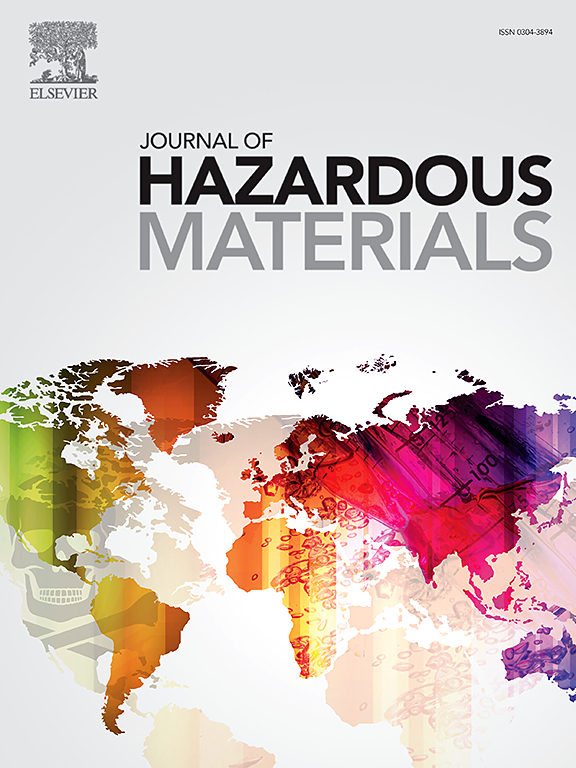聚苯乙烯纳米塑料和银纳米颗粒的联合暴露通过增加银积累而加剧了铁下垂途径介导的斑马鱼肝毒性
IF 12.2
1区 环境科学与生态学
Q1 ENGINEERING, ENVIRONMENTAL
引用次数: 0
摘要
纳米银粒子(AgNPs)因其抗菌特性而被广泛使用,导致其释放到环境中,随后在食物链中产生生物累积和生物放大作用。聚苯乙烯纳米塑料(PSNPs)作为新兴污染物,可作为污染物的载体并改变其转化过程。然而,与这些污染物共存相关的毒理学效应和潜在机制在很大程度上仍未得到探索。本文以斑马鱼为模型生物,探讨了急性联合暴露于 PSNPs 和 AgNPs 的肝毒性效应及其内在机制。暴露于 PSNPs 和 AgNPs 后的斑马鱼幼体(受精后 120 小时)表现出脂质代谢紊乱、氧化应激增加、肝肿大和肝功能异常,这些影响比单独暴露于 AgNPs 时更为明显。肝脏毒性的增加可能是由于 AgNPs 在联合暴露下的累积增强所致。机理研究发现,联合暴露导致丙二醛和 Fe2+ 水平显著升高、线粒体嵴缺失和膜电位降低,以及铁变态反应相关基因的异常表达,这些都是铁变态反应的标志性指标。此外,引入铁突变抑制剂去铁胺可减轻所有观察到的肝毒性表型,从而证实 PS+AgNPs 共同暴露可通过铁突变途径诱导肝损伤。同时,聚苯乙烯纳米塑料经常作为载体,改变吸附污染物的生物毒性。然而,有关纳米塑料吸附的纳米材料毒性的研究却很少。本研究考察了在同时暴露于环境相关浓度的 AgNPs 和未观察到影响浓度的 PSNPs 的情况下,斑马鱼肝脏的毒性增加。研究提出了一个新见解,即同时暴露于 PSNPs 和 AgNPs 会通过铁突变诱发斑马鱼肝损伤。这项研究为评估同时暴露于微塑料和纳米材料的生态风险和毒性效应提供了参考。本文章由计算机程序翻译,如有差异,请以英文原文为准。

Combined exposure of polystyrene nanoplastics and silver nanoparticles exacerbating hepatotoxicity in zebrafish mediated by ferroptosis pathway through increased silver accumulation
Silver nanoparticles (AgNPs) are extensively utilized for their antibacterial properties, leading to their release into the environment and subsequent bioaccumulation and biomagnification within the food chain. Polystyrene nanoplastics (PSNPs), as emerging pollutants, act as carriers for contaminants and alter their transformation processes. However, the toxicological effects and underlying mechanisms associated with the coexistence of these pollutants remain largely unexplored. Herein, the hepatotoxic effects and underlying mechanisms of acute combined exposure to PSNPs and AgNPs were explored using zebrafish as a model organism. After exposed to PSNPs and AgNPs, the larvae (120 hours post-fertilization) exhibited lipid metabolism disorders, increased oxidative stress, hepatomegaly, and liver dysfunction, with these effects being more pronounced than those observed with AgNPs exposure alone. This increase in hepatic toxicity may be due to the enhanced accumulation of AgNPs under combined exposure. Mechanistic investigations revealed that co-exposure led to a significant elevation in malondialdehyde and Fe2+ levels, a loss of mitochondrial cristae and a decrease in membrane potential, along with the abnormal expression of ferroptosis-related genes, which are hallmark indicators of ferroptosis. Furthermore, the introduction of the ferroptosis inhibitor deferoxamine alleviated all observed hepatotoxic phenotypes, thereby confirming that PS+AgNPs co-exposure induced liver injury through the ferroptosis pathway.
Environment implication
As antibacterial agents, silver nanoparticles are prevalent in the environment and pose ecological risks. Simultaneously, polystyrene nanoplastics often serve as carriers, altering the biotoxicity of adsorbed pollutants. However, research on the toxicity of nanomaterials adsorbed by nanoplastics is scarce. This study examined the increased toxicity on zebrafish livers under co-exposure to environmentally relevant concentrations of AgNPs and no observed effect concentrations of PSNPs. It proposed a novel insight that co-exposure to PSNPs and AgNPs induced liver injury in zebrafish through ferroptosis. This study provides reference for assessing the ecological risks and toxic effects of combined exposure to microplastics and nanomaterials.求助全文
通过发布文献求助,成功后即可免费获取论文全文。
去求助
来源期刊

Journal of Hazardous Materials
工程技术-工程:环境
CiteScore
25.40
自引率
5.90%
发文量
3059
审稿时长
58 days
期刊介绍:
The Journal of Hazardous Materials serves as a global platform for promoting cutting-edge research in the field of Environmental Science and Engineering. Our publication features a wide range of articles, including full-length research papers, review articles, and perspectives, with the aim of enhancing our understanding of the dangers and risks associated with various materials concerning public health and the environment. It is important to note that the term "environmental contaminants" refers specifically to substances that pose hazardous effects through contamination, while excluding those that do not have such impacts on the environment or human health. Moreover, we emphasize the distinction between wastes and hazardous materials in order to provide further clarity on the scope of the journal. We have a keen interest in exploring specific compounds and microbial agents that have adverse effects on the environment.
 求助内容:
求助内容: 应助结果提醒方式:
应助结果提醒方式:


